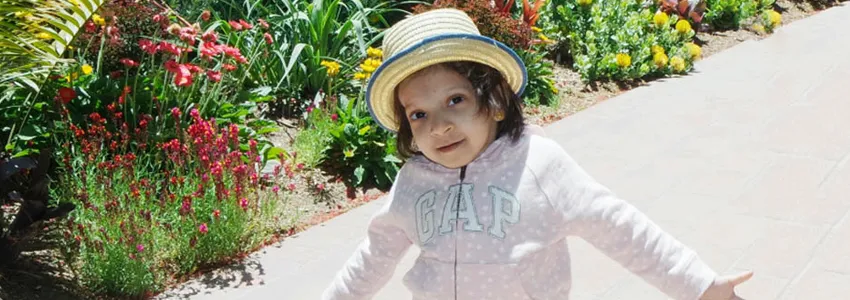
Photo courtesy of Shriya's family.
Stanford Medicine Scope - April 28th, 2021 - by Daphne Sashin
Nine-year-old Shriya recently learned to ride a scooter. That was a big deal for a girl who, not so long ago, spent 14 hours a day on dialysis for kidney failure and could run only a few steps before getting tired.
Every parent thinks their child is one in a million, but Shriya truly is. She was born with Schimke immuno-osseous dysplasia, a genetic, multisystem disorder affecting just one in a million children in North America. Children with the disease have shortened limbs and trunks, immune system problems and kidney disease. They historically have lived an average of nine years.
Given how unique she is, it is fitting that Shriya also had the distinction of receiving Stanford Children's Health's 1,000th stem cell transplant, in a revolutionary technique that represents the frontier for previously incurable kidney disease, a Stanford Children's Health article explains.
"Shriya represents a new frontier of the stem cell transplantation field, so it's incredibly exciting that she was our 1,000th stem cell patient," said Alice Bertaina, MD, PhD, associate professor of pediatrics (stem cell transplantation) and co-director of the Bass Center for Childhood Cancer and Blood Diseases at Lucile Packard Children's Hospital Stanford.
A pioneering approach
Shriya, whose family lives in Oregon, was the third Schimke immuno-osseous dysplasia patient at Stanford Children's Health to be treated using a two-transplant approach that decreases the risk of organ rejection and the need for long-term anti-rejection drugs.
First, doctors perform what's called a haploidentical stem cell transplant, where they take healthy blood-forming cells from a donor who is a half genetic match -- usually a parent -- to give the child a new immune system. In a later procedure, the child receives a kidney transplant from the same parent.
Kidney transplants typically last about 10 to 12 years because of the constant threat of rejection, the article notes. In other cases, children with the condition have not survived because their bodies couldn't tolerate the anti-rejection medicines.
By doing the bone marrow transplant first, a child's body thinks the kidney is his or her own -- so Shriya's new kidney could last a lifetime.
Bertaina, who pioneered the haploidentical stem cell transplant technique -- has been using it to treat children with cancers and blood diseases, so applying it to Schimke immuno-osseous dysplasia patients was new. Stanford Children's Health has treated three patients with the condition using this method -- Shriya and two siblings.
"With the first SIOD patient it was almost an unthinkable idea, and now it's a reality. We can offer children this chance at a cure, and that's very exciting," Dr. Bertaina adds.
'A dream come true'
Shriya underwent her stem cell transplant in January 2020 and her kidney transplant six months later. Both transplants went well, and Shriya is symptom-free.
"Shriya went from taking 10 medicines right after her kidney transplant to taking none, today," said her father, Shyam, who asked that their last name be kept private. "Before the transplants, she had energy to climb only one set of stairs. Now, she runs up and down them all day long."
As the article notes, doctors at Stanford Children's Health are optimistic that this approach could be used to treat other rare, genetic diseases -- and maybe, someday, all types of kidney disease.
Today, Shriya is challenging the odds for her disease and making big plans. First was the scooter. Next came learning to ride a bike.
"Before we came to Stanford, all we could do was dream about a real treatment for Shriya," her father said. "Stanford offered something that we never imagined would be possible, and it's totally a dream come true."
Read the full story on Shriya's experience here.

